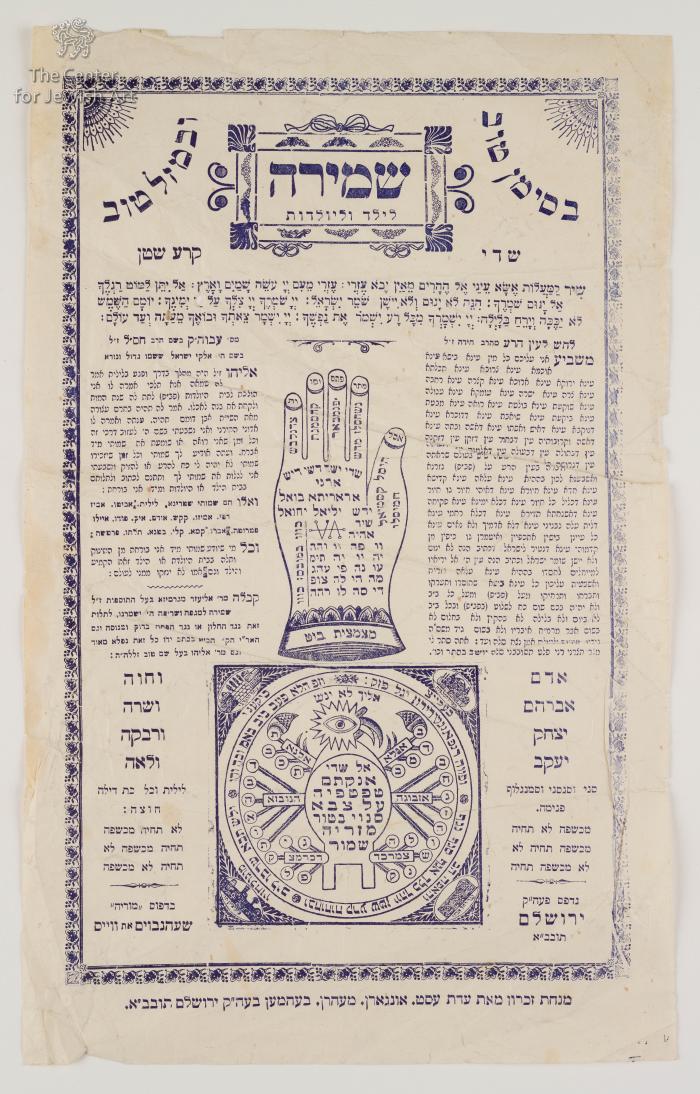Obj. ID: 54062 Shmirah le-Yeled ule-Yoledet, Jerusalem, circa 1930

sub-set tree:
O | Ornamentation: | Title, framed
H | Hamsa
A | Angel | Angel, multi-winged
J | Jerusalem | Sites in Jerusalem: | Western Wall (Kotel) הכותל המערבי
H | Holy and other places in the Land of Israel | Holy Tombs | Rachel's Tomb
H | Holy and other places in the Land of Israel | Holy Tombs | Cave of Machpelah (Tomb of the Patriarchs/Matriarchs)
J | Jerusalem | Zion, Holy City עיה'ק ציון
|
The following description was prepared by William Gross:
From earliest times, man has tried to protect himself from misfortune by the use of objects that he considered holy or otherwise (e.g., magically) potent. Amulets and talismans are Items generally worn around the neck or wrist, carried in a pocket or purse, or hung on a wall. They are meant to protect or aid those who carried or wore them. The Hebrew word for the amulet, kame‘a, has the root meaning "to bind". Jewish amulets are usually comprised of texts (either letters or graphic symbols) that are inscribed on some sort of material; some may also contain plant matter or precious stones. The texts of amulets usually include holy names that are believed to have the ability to affect reality, along with incantations summoning angels or other magical powers. For the most part, an amulet has a specific purpose: to ease childbirth, facilitate recovery from illness, improve one’s livelihood, and so on, but in the modern world many are also made for general protection.
Printed amulets that could serve the purpose of hand-written talismans began to appear in the late 17th century, continuing into the 18th and 19th centuries. The few surviving examples from this period are of European origin. But in the 19th century, they began to be published almost as soon as the printing press in North Africa and the Middle East. In Jerusalem, such amulets began to be printed within the first decade after a printing house opened in Jerusalem in 1841.
This example is a form that appeared in the 1890s from the presses of Zickerman and Levi but soon became the traditional Jerusalem birth amulet. Part of the imagery presents a protective angel with texts that was the defining image of a great many amulets printed in Jerusalem. The image originated in Eastern Europe but was copied in the Holy Land and became exceedingly popular as an amuletic device on publications in Jerusalem. The second part of the imagery is a hand, represented by the traditional form of the "wisdom of the hand", a form of Kabbalistic hand htat may hint at the protective hamsa as well. This version of the amulet contains the Shir LeMa'alot, a "Lachash" against the evil eye by the Chida and the story of Eliyahu meeting Lilith.
Shenboim and Weiss, the printers of this amulet, copied the form from those of Levi and Zuckerman, showing the continuation of this popular form that became the standard form of birth amulet in Jerusalem, the imagery presents both a protective angel and a hand, represented by the traditional form of the "wisdom of the hand" and the central element of the hamsa, providing protective values to the printed sheet. This version of the amulet contains the Shir LeMa'alot, a "Lachash" against the evil eye by the Chida and the story of Eliyahu meeting Lilit.
Printer: Shenboim & Weiss



